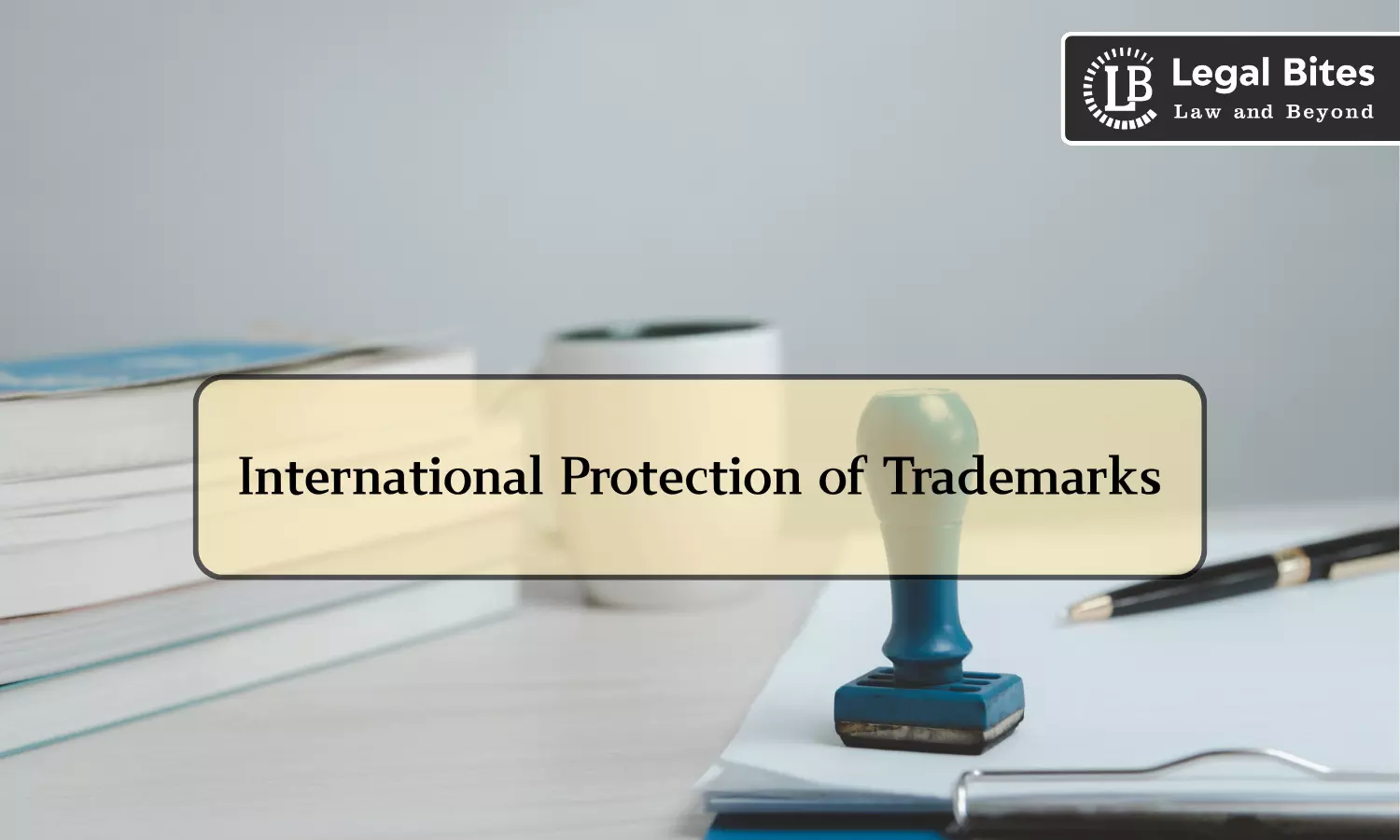International Protection of Trademarks
This article examines the rationale, key treaties, legal frameworks, and enforcement tools involved in the international protection of trademarks.

Trademarks are a cornerstone of brand identity and business reputation. In a globalised marketplace where products and services transcend borders through digital and physical trade, the need for international protection of trademarks has become indispensable. Without a cohesive mechanism to protect trademarks globally, businesses risk infringement, dilution, or unauthorised exploitation of their brand identity.
This article explores the rationale, legal frameworks, treaties, and enforcement mechanisms that constitute the international protection of trademarks. It also examines challenges and developments in global trademark law.
Meaning and Importance of Trademarks
A trademark is a distinctive sign capable of identifying the goods or services of one enterprise from those of others. It can consist of words, logos, colours, shapes, sounds, or a combination thereof. Trademarks are protected by intellectual property rights under national and international laws.
The key functions of trademarks are:
- Identification of origin
- Quality assurance
- Advertising and brand image
- Legal protection against unfair competition
Global businesses such as Apple, Coca-Cola, and Nike rely heavily on trademark protection to secure market position and consumer loyalty across jurisdictions.
Why International Trademark Protection is Needed
As companies expand globally, trademarks need protection beyond domestic borders. Some of the key reasons include:
- Cross-border e-commerce and international advertising
- Risk of counterfeiting and piracy
- Franchise and licensing agreements
- Ease of expansion into foreign markets
- Legal certainty and brand consistency
Local registration only offers protection within that jurisdiction. Without international mechanisms, rights holders would have to register separately in each country, increasing costs and complexity.
International Legal Frameworks for Trademark Protection
The international protection of trademarks is governed by multiple multilateral agreements and administered by global institutions such as the World Intellectual Property Organisation (WIPO) and the World Trade Organisation (WTO).
1. The Paris Convention for the Protection of Industrial Property (1883)
The Paris Convention was the first major international treaty for the protection of industrial property, including trademarks. Key provisions include:
- National treatment: Each member state must give the same protection to foreign applicants as it gives to its nationals.
- Right of priority: A trademark applicant can file in other member countries within six months of the original filing and retain the original filing date.
- Protection against unfair competition.
2. Madrid System for the International Registration of Marks
Administered by WIPO, the Madrid System includes:
- Madrid Agreement (1891) and
- Madrid Protocol (1989).
This system allows a trademark to be registered in multiple countries by filing a single application through a national or regional IP office.
Key Features:
- Centralised application and management.
- Cost-effective and time-saving.
- Allows designation of over 130 countries.
3. TRIPS Agreement (1994)
The Agreement on Trade-Related Aspects of Intellectual Property Rights (TRIPS) is a WTO agreement that mandates minimum standards for IP protection, including trademarks.
Key Provisions:
- Definition and duration of trademarks (Article 15–18).
- Well-known mark protection (Article 16(2) & (3)).
- Compulsory procedures for enforcement and dispute resolution.
4. The Nice Agreement (1957)
This agreement provides for the International Classification of Goods and Services (Nice Classification), a standardised system used in trademark registration.
5. The Vienna Agreement (1973)
It established a system for the classification of the figurative elements of marks, aiding in the search and examination of image-based trademarks.
Regional Arrangements
1. European Union Trademark (EUTM)
The European Union Intellectual Property Office (EUIPO) provides a unitary system allowing registration across all EU Member States via a single application.
Legal Basis: Regulation (EU) 2017/1001 on the European Union Trade Mark.
2. African Regional Intellectual Property Organisation (ARIPO)
Under the Banjul Protocol, a trademark registered with ARIPO can be protected in designated member states.
3. Organisation Africaine de la Propriété Intellectuelle (OAPI)
OAPI provides a centralised IP system for 17 Francophone African countries.
4. Andean Community and ASEAN IP Systems
Regional frameworks are also available in South America and Southeast Asia, although not as integrated as the EU model.
Protection of Well-Known Trademarks
International law accords higher protection to well-known trademarks, even if unregistered in a specific jurisdiction, as per:
- Paris Convention (Article 6bis)
- TRIPS [Article 16(2) & (3)]
In General Motors Corp. v. Yplon SA (1999, ECJ), the European Court clarified that well-known trademarks must be recognised by a substantial portion of the public concerned with the goods/services.
Indian courts have also upheld protection of well-known marks in N.R. Dongre v. Whirlpool Corp. (1996), recognising trans-border reputation.
Enforcement and Dispute Resolution
1. National Enforcement Mechanisms
Most jurisdictions require domestic registration for enforcement. Remedies include:
- Injunctions
- Damages or account of profits
- Customs seizure
- Criminal penalties for counterfeiting
2. International Dispute Mechanisms
- WTO Dispute Settlement Body (e.g., U.S.–China IP Enforcement dispute)
- WIPO Arbitration and Mediation Centre: Handles disputes over domain names and trademarks.
Example: UDRP (Uniform Domain-Name Dispute-Resolution Policy) applies to cybersquatting disputes.
Challenges in International Trademark Protection
Despite significant progress, the global trademark protection regime faces several challenges:
a) Territorial Nature of Trademarks
Trademark rights are still territorial. Unless registered via the Madrid Protocol or regional systems, separate filings are needed.
b) Inconsistent Legal Standards
The definition of use, distinctiveness, and classification varies across jurisdictions, leading to procedural complexity.
c) Cybersquatting and Domain Name Issues
Domain names are global, but trademarks are national. This leads to conflicts, especially in cases of brand hijacking on websites.
d) Counterfeiting and Enforcement
Counterfeit goods cost the global economy billions annually. Weak enforcement in some countries dilutes brand value.
e) Language and Script Issues
Different scripts (e.g., Latin, Arabic, Chinese) may result in phonetically or visually similar marks escaping detection.
Recent Developments
1. Use of AI and Blockchain
WIPO and national IP offices are integrating AI tools for trademark search and classification. Blockchain is being explored for proof of use and timestamping rights.
2. Digital Platforms and Brand Protection
Platforms like Amazon, Alibaba, and Meta now offer brand registry and notice-and-takedown mechanisms to help trademark owners enforce rights.
Conclusion
The international protection of trademarks is a vital aspect of modern intellectual property law. While the global legal architecture—led by the Paris Convention, Madrid Protocol, and TRIPS—provides a robust foundation, effective enforcement still depends on national implementation and global cooperation.
As businesses expand across digital and physical frontiers, adapting to regional nuances, combating infringement, and proactively registering trademarks remains the best shield against brand dilution. With new technologies and harmonisation efforts, the future of international trademark protection holds promise, but vigilance remains key.
References
- Paris Convention for the Protection of Industrial Property, 1883 – WIPO
- Madrid Protocol, 1989 – WIPO
- WTO Agreement on TRIPS, 1994
- Regulation (EU) 2017/1001 – European Union Trademark Regulation
- N.R. Dongre v. Whirlpool Corporation, (1996) 5 SCC 714
- General Motors v. Yplon SA, Case C-375/97, European Court of Justice

